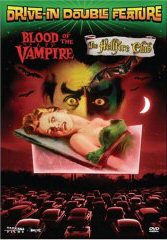
A night-cloaked staple of fantastic storytelling since Man first felt a cold breath across his throat, the vampire as symbol/theme has become something of both a blessing and a curse in the genre, with modern incarnations of the undead threatening to suck the blood right from the monster's dark heart. Just as often provoking laughter as scares, the vampire, that primal symbol of paradoxical lust and fear, stalks our minds as destructively as he breaks through our skin. Due to overexposure and bad craftsmanship, Nosferatu has become a parody, diluting the themes of desire and mortality which it once so powerfully evoked. The first film in a new double feature package from the fine folks at Dark Sky, Blood of the Vampire attempts to breath new life (pardon the pun!) into the lifeless throat of the undead by turning several conventions of the moldy undead on their ear. Namely, there are no actual vampires in the film! The resulting mixture of mad science and the pseudo Gothic is a mixed blessing, occasionally weak in story but attaining impressively chilling atmosphere.
Resembling such films as the 1960's Italian shlock-fest Atom Age Vampire and other pseudo-scientific thrillers of its ilk, this feature casts the vampire in a more naturalistic light, focusing on science rather than superstition. Blood of the Vampire is a modern interpretations of ancient psychological perversions. A story borrowing from the techno-medical horrors of early Universal films and some of the early gory European horrors features a husband and wife terrorized by Dr. Callistratus, a brilliant madman who has returned to half-life after being executed. Resurrected by a heart transplant, he and his crippled assistant Carl, serves as the 'vampire' of the title, conducting medical research on blood deficiency, sampling his wares on inmates in a prison hospital to nourish his stolen life.
Steeped in shadowy atmosphere, this picture is a treat for the eyes, and an intelligent effort to bring believability to the hoary archetype with which it deals. Despite occasional hammy acting and lackluster camera compositions, Blood of the Vampire is a well made, competent thriller in the tradition of Dr. X and The Monster and the Girl, as well as several other gothic-medical hybrids that combined science with the supernatural. While there are no true occult elements, the film presents enough macabre atmosphere to warrant its inclusion in the horror fan's diet. Its psychological focus and unique slant makes it a respectable addition to this particularly effective hybrid sub-genre, treating the 'vampirism' as a medical condition, and as such, re-visioning the grim beauty of its source material.
The Hellfire Club, the second feature, is less substantial, and less socially relevant. Not as complex a storyline, the plot is designed more as a simple adventure story than a thriller, lacking either supernatural content or the spectral atmosphere that lent polish to the before mentioned title. In a plot that reads like a pulp novel, Jason (Keith Mitchell) returns home years after fleeing his ancestral estate, having been raised by circus performers. Wishing to re-claim his heritage and material wealth, he finds his designs complicated by a scheming, quite transparent cousin Thomas (Peter Arne), whose overacting does little to make the story believable. Jason must face his cousin, who has troublesome ties with the Hellfire Club, a disreputable association from actual history. The legendary atmosphere of this club, and the dangers of the unknown/violence that they represent, are the major forces that propel the plot. Without this group's affiliation the story would have quickly descended into a soap opera. Regrettably, the exploits of the Hellfire Club are downplayed. A historical secret society of suspected murders, sexual license, and political intrigue, the club is simply a narrative device. In fact, the sensationalism hinted at was rather diluted stuff even by that era's standards. Despite these complaints, as an action and historical piece, the movie satisfies. Boasting the production values and lyrical settings of many Hammer films, particularly the high-spirited adventures that were churned out before that studio discovered Gothic horror, Sangster's script is enhanced by beautiful locations and charm.
Complete with extra material that smacks of Drive-In goodness, bringing back memories of those late night Fridays when you were perhaps more interested in the back seat than the screen, both of these films look excellent, having been re-mastered for optimal picture and sound. Blood of the Vampires, presented in 1.85:1, is surprisingly lush, with no noticeable grain or damage. The Hellfire Club is offered in 2.35:1, and while not quite as clean (with occasional scratching), is nevertheless impressive. Audio for these three hours of nightmarish action is presented in undistorted 2.0 Mono. Biographies for principle actors and crew are surprisingly informative, and the audio commentary with Jimmy Sangster and Robert S. Baker is filled with amusing memories and surprising admissions, including similarities between Blood of the Vampire and other Hammer product, the nuances of setting, and bits of trivia covering several of Sangster's other works. The lack of vampires is discussed as is the idealistic/financial challenges of producing the picture. Both gentlemen provide full, informative talks that suggest as much about their personalities as the topics at hand. Additional extras for these nostalgic goodies include refreshment stand adds, classic Drive-In adds, wonderfully exploitative previews, and intermissions, lending authenticity to the viewing experience. Simply put, this is yet another success in Dark Sky's admirable Drive-In Double Feature line-up. Throw that disc in and grab some popcorn . . .
Review by William P. Simmons
| Released by Dark Sky Films |
| Region 1 - NTSC |
| Not Rated |
| Extras : |
| see main review |